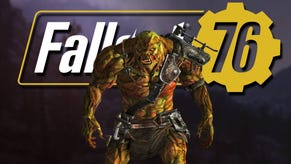Fallout 76 is a "live game" with a huge emphasis on crafting
Fallout 76 is all multiplayer, all the time, and you'll need to lean into the crafting system to survive.
During its E3 reveal, Fallout 76 was confirmed to be a multiplayer only title, with none of the single-player campaign that fans of the series are used to.
The game was rumoured to be a survival RPG in the same vein as DayZ and Rust, and Danny O'Dwyer's Noclip Fallout 76 documentary has shed further light on how surviving the wasteland will play out, as well detailing the importance of the crafting system.
Fallout 76 is a "live game," like Destiny, so at some point, players will have reached a point where they've completed everything. As far as end-game content goes, that's where the "cyclical nuclear war" comes into play, challenging high level players with high level areas that are home to rare loot and items.
As well as the PvP aspect of roaming the map, a 12-vs-12 team death match mode is also being looked into.
To prevent things from getting too raucous in the main body of the game, servers will be typically limited to around 24 players although that might expand to 32.
Hooking up with your buddies won't be too much of a rigmarole either, with players able to easily hop onto the servers that their friends are on. Player teams are limited to four slots right now, but that may change going forward.
All of the usual bells and whistles of online games will be present, like voice chat and emote wheels, as well as a photo mode.
If you end up getting killed - through misadventure or at the hands of another player - the death penalty will be kept as light as possible, with players respawning in an area as close to where they died as possible. Meanwhile, aggressive players will be given wanted levels, to keep them in check to some degree.
Hostile players, creatures, or falling off a mountaintop aren't the only dangers to be on the lookout for.
In terms of survival, players will need to eat and drink to stay alive. Food will rot, and items will degrade, meaning you'll have to keep a watchful eye on your inventory.
Cooking food makes the whole process more efficient, and similar to the cooking mechanic in Fallout 4, the process imparts certain bonuses on ingredients when they're combined or cooked, rather than eaten raw.
The potential effects can also make you more or less susceptible to disease. Because that's a thing now.
As well as contracting diseases, players also run the risk of mutating, although it's not all bad news.
Fallout 4's inverse HP bar, that represents both your health and how irradiated you are, will still be present, but the more rads you have, the higher the chance for a mutation. Most mutations aren't accompanied by visual changes, but a handful will be.
The mutations work in a similar way to traits from Fallout 1 and 2, with plus or minus effects. They can be cured, or - in the late game - you can make them a permanent part of your build.
Your build can be managed with Perk Cards, allowing you to craft or fight more efficiently. Each time you level up, you can pick a new Perk Card, but you'll be limited to how many you can have at a time.
The good news is that you can reroll and swap out the cards if you fancy a change.
Perk Cards can even be shared within a team, letting members focus on specific roles, like medic, defense, crafting, combat, cooking, and so on.
In order to craft items, players will need to find recipes and parts in the world to build camps that function as mini workshops. They can be built almost anywhere, although there are restrictions - for example you won't be able to build one near the vault entrance, so that you can't grief players that are leaving the vault and entering the world.
Should you decide to move servers, and the area where your camp is located is available, you'll conveniently find it in the exact same spot. If the area is occupied, it'll be packed up, ready for you to plonk down elsewhere.
The map will also feature public workshops, that can be claimed after clearing out the various mutated inhabitants that have set up shop inside. Once they've been cleared out, the workshops can be fortified, and players can access the resources within, like ore, and use them to craft much-needed items, like bullets.
Crafting will be a huge part of the game, with specific plants and animals being a source of materials that you'll need in order to make ammo, armour, power armour pieces, and more. You'll need to traverse the different areas of the map and slaughter the bevy of monstrosities found there to get your hands on the specific materials you need.
Crafted items can be sold to other players, so if you're after caps, you might want to specialise in certain items that you know will be highly sought after.
Fallout 76 launches on November 14 on PC, PS4, and Xbox One and will be a full-priced game.
While it will feature microtransactions, the purchasable items will be cosmetic only, and they can also be earned through gameplay.
The paid content will effectively support the dedicated servers and allow Bethesda to provide free updates for "years to come."
The studio plans to maintain a regular stream of content into the game through frequent smaller updates, like new items and events, to bigger content drops that are more sporadic.












